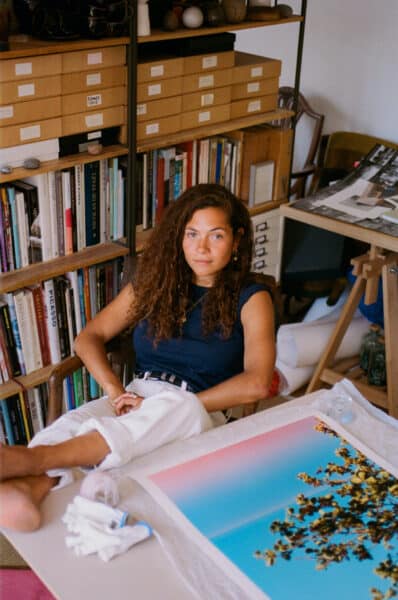How do you approach photography and what are the key themes you’re drawn to exploring?
I’m driven by the desire to capture and freeze time through my analogue film cameras. My photographs celebrate the jewels of Britain: the cityscapes and country life. It’s a collection of modern day Britain, the urban and rural, from the outdoors in daytime to fashionable city nightlife. I shoot on London’s urban streets, out on Yorkshire’s moors, and among the wild heaths on Cornish clifftops.
After losing my hearing from a young age I now wear a cochlear implant which replaces acoustic hearing with electric. As an artist, I am constantly searching for the imitation of sounds in my daily life, through both silence and the electronic sounds that my cochlear implant gives me.

Have you always been interested in photography? Was there a moment when a hobby became a career, or did you set out on a specific path to be a photographer?
I grew up in a household of performing arts. My mother is a casting director and my father is a film and stage actor. While my sister took a path into theatre production, I became interested in photography after my photographer godfather, Andrew Forrest, introduced me to the magical world of the camera.
I intuitively chase natural light and settings in order to depict the most honest version of my sitters.
I studied photography at Bournemouth Art Institute then worked as an assistant with the photographer and director Sam Taylor-Johnson. After that I worked at The Photographers’ Gallery in Fitzrovia, London, alongside 20th century photographer pioneer Dorothy Bohm.
I was very lucky in the sense that I knew, from a young age, that I wanted to be a photographer. I think I realised that photography doesn’t require sounds and so I used it as a tool to communicate with the hearing world.

Lily in her studio, shot by Evie Milsom
Why do you choose to shoot in film?
For me nothing quite beats the feeling of shooting on film. I intuitively chase natural light and settings in order to depict the most honest version of my sitters.
The quality and colours that comes from film photography is magical and surreal. I love the journey of taking the photos on my film camera, to processing and development in my darkroom, to making hand prints from them.

Your camera lens has focused on Paul McCartney to Thandie Newton and many more… What’s it like working with people you admire? How do you go about building a rapport?
It’s always very exciting meeting and shooting popular personalities. I try not to let that ‘rattle’ me. At the end of the day, they are people just like me and you. I use the time I have with them to get to know them before snapping away. My goal is to capture their true self – a real sense of who they are. I treat them as a new friend and I apply that same approach to everyone I meet along the way.
Is there anyone you would still like to shoot?
I would love to shoot one of my favourite authors, Zadie Smith. She’s also a north west Londoner of similar heritage. I grew up reading her books and saw her as an inspiring role model when I was younger. She continues to amaze me.
Can you tell us about your creative / photography process? Does it differ between commissioned and personal projects?
There’s more freedom with my personal work. It’s led to commissions, as clients hire me for my style. I enjoy brainstorming projects and shoots with clients. Every project is different – which is one of the many things that makes my work very exciting and refreshing.
My personal work develops over time. I always try to carry a camera with me everywhere I go and regret it when I don’t. Any missed moments and opportunities haunt me for forever!
The quality and colours that comes from film photography is magical and surreal. I love the journey…
Have you ever found your work or creativity affected by a client’s request?
It depends on the project and the brief. I always want my shoots to be as relaxed as possible. I want everyone on set to have a great time and I see it as a collaboration. From the lighting person to the makeup artist, everyone shares the same goal, to produce beautiful work to the best of their abilities.

What has photography taught you about life?
Life is spontaneous. Improvise to the best of your ability and do what feels natural to you.
Where or how do you find inspiration?
Everyone and everywhere I meet. I’m usually chasing that perfect magical light and that right moment.
What are you hoping to achieve with your work?
To stop you in your tracks and to be remembered for capturing life’s delights.
What’s your creative goal or mission?
To keep taking photos no matter what! To continue growing and evolving my work. I would also like to try moving image too.

This issue of Strike revolves around different perspectives on sustainability and climate action. How does that play into your work?
The longer I’ve been shooting the more I’ve been drawn to capturing nature, the landscapes and the seas around the world. It saddens me to hear and see how much damage we are doing to our beautiful planet. I think education and awareness is the key and photography has the power to do exactly that.
What does the future hold for your practice?
My camera is the key that opens the doors to the wonders of the world. I look forward to going through them.
+
See more of Lily’s work at lilybertrandwebb.com and on her Instagram
Image credits
Lily in her studio – Evie Milsom
All other images by Lily Bertrand-Webb:
Trellick Tower, London
Charlie Casely-Hayford
Jodie Ounsley
Ladbroke Grove, London